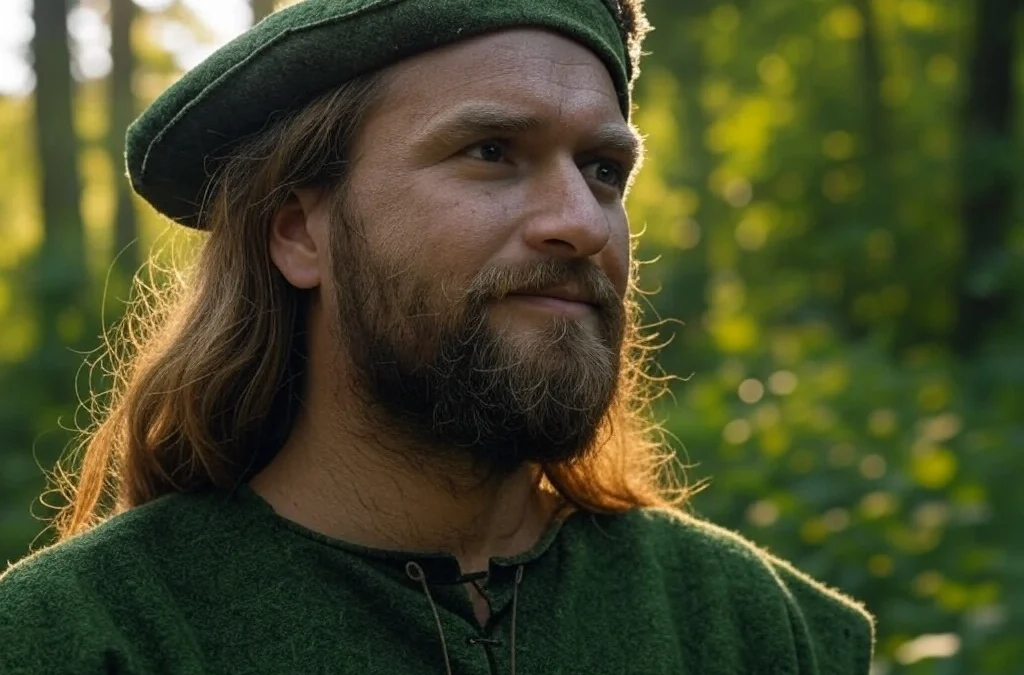Legends have fascinated people for centuries. These traditional stories mix real history with imagination. From ancient warriors and lost cities to mysterious creatures, legends are found in every culture around the world.
This article will take you through over 100 of the most famous and interesting legend examples. You’ll learn what a legend is, how legends differ from myths, and why legends remain important today.
Legends inspire us. They explain the past and keep traditions alive. Whether it’s King Arthur, the Loch Ness Monster, or Robin Hood, these stories continue to capture our interest.
What Is a Legend?
A legend is a traditional story or narrative passed down through generations, often rooted in historical events or real people, but embellished with imaginative details. Legends typically explain the origins of places, customs, heroes, or extraordinary events. They blend fact and fiction, making them different from pure myths or fairy tales.
Legends are most commonly associated with cultural history and folklore. Famous examples include King Arthur and the Knights of the Round Table, Robin Hood, and El Dorado. These stories often serve to inspire, teach moral lessons, or preserve cultural identity.
In folklore studies, a legend is distinguished by its connection to a particular time and place, often featuring realistic settings and believable characters, even when supernatural elements are present. Legends can be regional or global, and they evolve over time as they are retold.
Whether about heroes, monsters, lost cities, or unexplained phenomena, legends remain a vital part of human storytelling and cultural heritage.
100 Examples of Legends
1. King Arthur and the Knights of the Round Table
King Arthur is the legendary British leader said to have defended Britain from invaders in the 5th and 6th centuries. Guided by the wizard Merlin, Arthur wields the magical sword Excalibur. His court at Camelot and the fellowship of the Round Table symbolize chivalry, honor, and loyalty.
2. Robin Hood
Robin Hood is the legendary English outlaw who, with his band of Merry Men, stole from the rich and gave to the poor. Stories of his clever tricks and archery skill have made him a folk hero for centuries. Sherwood Forest remains forever linked with his name.
3. Beowulf
Beowulf, the hero of the oldest surviving English epic, battles the monster Grendel, Grendel’s vengeful mother, and later a fearsome dragon. The story blends myth and history to explore themes of bravery, legacy, and the passing of time.
4. William Tell
William Tell is a Swiss folk hero. According to the legend, he shot an apple from his son’s head under threat from a tyrannical ruler. His defiance helped spark the Swiss struggle for independence.
5. Lady Godiva
In protest of heavy taxes imposed by her husband, Lady Godiva famously rode naked through the streets of Coventry. Out of respect, the townspeople supposedly looked away. Her ride remains a symbol of selfless courage.
6. The Loch Ness Monster
Affectionately nicknamed “Nessie,” this legendary beast is said to dwell in Scotland’s Loch Ness. First reported in the 6th century, modern sightings surged in the 20th century, sparking ongoing global fascination and tourism.
7. The Fountain of Youth
Tales of a magical spring that restores youth span cultures. Spanish explorer Juan Ponce de León was said to search for it in Florida. Though no fountain was found, the idea of eternal youth captivates imaginations even today.
8. El Dorado
El Dorado, “The Golden One,” was thought by Spanish conquistadors to be a lost city rich beyond measure in South America. The legend probably started with the real Muisca tribe ritual of covering their king in gold dust.
9. Atlantis
First described by Plato, Atlantis was said to be a wealthy, advanced island civilization that vanished beneath the sea in a single day. Its story warns of arrogance and serves as inspiration for countless books and theories.
10. The Flying Dutchman
Sailors fear the ghostly ship known as The Flying Dutchman, doomed to roam the oceans forever. Tales from the 17th century claim it appears during storms as a warning of disaster.
11. Paul Bunyan
Paul Bunyan is a giant lumberjack from American folklore. With his blue ox Babe, he shapes rivers and mountains with ease. His tall tales celebrate the rugged frontier spirit of North America.
12. Johnny Appleseed
Born John Chapman, Johnny Appleseed wandered barefoot across the American Midwest planting apple seeds. Beyond the trees, he became a symbol of kindness, generosity, and respect for nature.
13. Pecos Bill
The legendary cowboy of Texas folklore, Pecos Bill was said to have invented rodeo, tamed wild mustangs, and even rode a cyclone. His wild adventures capture the exaggeration of tall tales.
14. The Headless Horseman
From Washington Irving’s The Legend of Sleepy Hollow, the Headless Horseman rides at night in search of his missing head. The chilling story became a Halloween classic and a symbol of spectral terror.
15. Cú Chulainn
A hero of Irish mythology, Cú Chulainn was known for his superhuman strength and “battle frenzy,” which made him nearly unstoppable. His tragic destiny as both protector and doomed warrior defines his legend.
16. The Blarney Stone
Located at Blarney Castle in Ireland, the stone is said to give the “gift of gab” to those who kiss it. Thousands of visitors lean backward over a high drop every year to test the legend.
17. The Yeti
Often called the “Abominable Snowman,” the Yeti is said to roam the icy Himalayas. Local Sherpa stories describe a large, ape-like creature. Despite expeditions, no definitive proof has ever been found.
18. The Chupacabra
This creature’s name means “goat-sucker” in Spanish. First reported in Puerto Rico in the 1990s, the Chupacabra allegedly preys on livestock by draining their blood. Its origins remain mysterious.
19. The Kraken
In Nordic legends, the Kraken is a sea monster of massive size, capable of dragging entire ships to the depths. Sailors described it as a gigantic octopus or squid appearing off Norway and Greenland.
20. The Basilisk
According to European legend, the Basilisk is a serpent king whose very glance can kill. Some stories say it is born from a serpent’s egg hatched by a rooster. It was believed to inhabit deserts and ruins.
21. Lech, Czech, and Rus (The Founders of Slavic Nations)
According to legend, three brothers followed a white eagle to found Poland, Czechia, and Rus’; Lech settled at Gniezno (“the nest”), establishing Poland’s first capital and national symbol.
22. Romulus and Remus (Founders of Rome)
According to legend, twin brothers raised by a she-wolf quarreled over the founding of Rome; Romulus killed Remus and gave his name to the city in 753 BCE.
23. The Pied Piper of Hamelin
This German tale tells of a mysterious piper hired to rid the town of rats. When unpaid, he used his magical pipe to lead the town’s children away. The story is a chilling reminder of broken promises.
24. The Golem of Prague
The Golem is a legendary figure created from clay by Rabbi Judah Loew to protect the Jewish community of Prague from persecution. According to lore, the creature came to life with the placement of a sacred word.
25. The Bell Witch
In early 1800s Tennessee, the Bell family reported being tormented by a malevolent spirit. The Bell Witch whispered, slapped, and scared them. The legend remains one of America’s most famous ghost stories.
26. The Jersey Devil
Said to haunt New Jersey’s Pine Barrens, the Jersey Devil is described as having wings, hooves, and a horrifying scream. Origin stories vary, but many trace it back to the cursed 13th child of Mother Leeds.
27. The Mothman
First sighted in 1966 near Point Pleasant, West Virginia, the Mothman has glowing red eyes and large wings. Sightings were reportedly followed by the tragic collapse of the Silver Bridge, fueling theories of it being an omen.
28. The Wendigo
From Algonquian folklore, the Wendigo is a cannibalistic spirit associated with winter and insatiable hunger. It embodies the danger of selfishness and greed, often said to possess people who commit acts of cannibalism.
29. Baba Yaga
Baba Yaga is a terrifying witch from Slavic folklore. She lives deep in the forest in a hut that stands on chicken legs. While often cruel, she sometimes offers wisdom to worthy travelers.
30. The Tanuki
The Japanese tanuki is a real animal (raccoon-dog), but folklore describes it as a mischievous shape-shifter. It’s known for playing tricks and carrying a magic leaf to transform into objects or people.
31. The Kitsune
In Japanese tales, Kitsune are foxes that grow multiple tails as they age and gain power. They can shape-shift into human form, often as beautiful women, and are both protectors and tricksters.
32. The Nian
Nian is a monster from Chinese folklore that terrorized villagers every Lunar New Year. The beast feared loud noises and the color red. That’s why firecrackers and red decorations are used in today’s celebrations.
33. The Eight Immortals
A popular group in Chinese mythology, the Eight Immortals each represent different social classes and possess unique magical tools. Their adventures are found in Taoist stories and are common motifs in art and literature.
34. Sun Wukong (Monkey King)
Sun Wukong, from the Chinese epic Journey to the West, is a rebellious monkey born from stone. Armed with a magical staff and the ability to cloud-leap, he defies the heavens and later seeks redemption.
35. The White Snake
The Legend of the White Snake tells of a snake spirit, Bai Suzhen, who falls in love with a human man. Their forbidden romance defies the boundaries between spirit and human worlds in Chinese folklore.
36. The Rainbow Serpent
An Aboriginal Australian creation figure, the Rainbow Serpent controls water and is linked to rain and fertility. Its colorful, winding body is said to have shaped rivers and landscapes across the land.
37. Maui
A legendary hero in Polynesian myths, Maui is known for fishing up entire islands with a magical hook and slowing the sun to make days longer. His cleverness and strength made him a culture hero across the Pacific.
38. The Taniwha
In Māori legend, Taniwha are powerful water beings. They may protect certain tribes or act as dangerous guardians of rivers and caves. Respect and offerings are said to keep them from turning hostile.
39. The Bunyip
The Bunyip is said to lurk in Australian billabongs and swamps. Descriptions vary, but it’s often depicted as a huge creature with a booming call. The legend likely arose from fears of the mysterious outback.
40. The Thunderbird
Among many Native American tribes, the Thunderbird is a supernatural bird whose wings create thunder and lightning. It symbolizes strength and power, often appearing as a guardian spirit in the sky.
41. The Skinwalker
In Navajo legend, Skinwalkers are witches with the terrifying ability to shape-shift into any animal. They are said to use this power to harm or deceive, making them figures of deep fear and taboo within Navajo culture.
42. Coyote (Trickster)
Coyote appears across many Native American traditions as a crafty and unpredictable figure. Often foolish as well as clever, his antics teach moral lessons through his constant troublemaking.
43. Anansi
Anansi the spider is a beloved figure in West African and Caribbean folklore. His stories show how cunning and intelligence often win over brute strength. He is considered the original storyteller.
44. The Tokoloshe
The Tokoloshe, from Zulu myths, is a small, hairy creature blamed for mysterious illnesses and mischief at night. People in some areas even raise their beds off the ground to keep it away.
45. The Ninki Nanka
This elusive, dragon-like creature is said to dwell in West African swamps. Descriptions vary, but it is generally feared and rarely seen. Its legend serves as a caution to stay away from dangerous waters.
46. Smok Wawelski (The Wawel Dragon of Kraków)
A cunning cobbler defeats the dragon terrorizing Kraków by feeding it a sulphur-stuffed sheep; the legend, tied to Wawel Hill, dates back to medieval chronicles and lives on at the famous dragon statue today.
47. The Griffin
The Griffin combines the body of a lion and the head and wings of an eagle. It symbolizes strength, courage, and protection. In medieval times, it was often depicted guarding treasure and sacred places.
48. The Unicorn
The Unicorn has captivated imaginations for centuries. It is portrayed as a pure, horse-like creature with a single spiral horn. Medieval tales described it as so elusive only a virgin could tame it.
49. The Selkie
From Scottish and Irish folklore, Selkies are seals that can shed their skin to become human. Often, their stories are tragic, involving stolen seal skins and longing to return to the sea.
50. The Kelpie
A dangerous shape-shifting water spirit from Scottish lore, the Kelpie appears as a beautiful horse by rivers and lochs. Once mounted, the rider becomes stuck and is dragged underwater to drown.
51. The Black Shuck
The Black Shuck is a ghostly black dog with glowing red or green eyes. Roaming the coasts and countryside of East Anglia, it is seen as a harbinger of death.
52. The Green Man
Found carved on churches and ancient buildings across Europe, the Green Man’s face is surrounded by or made of leaves. It represents nature’s eternal cycle of growth, decay, and rebirth.
53. The Wild Hunt
The Wild Hunt is a phantom procession of hunters and hounds racing across the night sky. Sightings in Germanic, Scandinavian, and British folklore were seen as an omen of war or disaster.
54. The Brownie
Brownies are household spirits from Scottish folklore. They secretly do household chores at night in exchange for small offerings of food. However, they will leave forever if offended.
55. The Redcap
A fearsome goblin of English and Scottish border legends, the Redcap haunts old castles. It is said to dip its cap in the blood of its victims to maintain its strength.
56. The Dullahan
The Dullahan is an Irish spectral rider carrying his head under one arm. Riding a black horse, he calls out names of those doomed to die. Doors and gates fly open at his approach.
57. The Banshee
A wailing female spirit from Irish mythology, the Banshee foretells death. Families who hear her eerie cry know a loved one is near the end of life. She’s said to be dressed in grey or white.
58. Changelings
According to European folklore, fairies would sometimes steal human babies and replace them with changelings. These fairy substitutes looked human but often behaved strangely or grew ill.
59. The Draugr
In Norse legend, the Draugr is an undead being that guards its treasure in burial mounds. Larger and stronger than living men, they emerge from their graves to torment the living.
60. Princess Wanda of Kraków
When a German prince threatened war, Princess Wanda chose sacrifice over surrender, saving Kraków; her burial mound still stands by the Vistula River as a symbol of Polish pride.
61. The Norns
In Norse mythology, the Norns are three powerful sisters who control fate. They weave the destinies of both gods and men at the base of Yggdrasil, the World Tree. Their names are Urd (past), Verdandi (present), and Skuld (future).
62. Jörmungandr
Jörmungandr, the Midgard Serpent, is a monstrous sea serpent from Norse legends. So enormous, it circles the earth and grasps its own tail. It is foretold to battle Thor during Ragnarök, the end of the world.
63. The Trolls
Trolls are iconic creatures in Scandinavian folklore. Living under bridges or in mountain caves, trolls are often hostile to humans. According to legend, they turn to stone when exposed to sunlight.
64. The Yule Cat
The Yule Cat (Jólakötturinn) is a terrifying feline from Icelandic folklore. It prowls the snowy countryside at Christmas, devouring anyone who has not received new clothes. It remains a chilling holiday warning.
65. The Huldra
In Norse folklore, the Huldra is a beautiful forest maiden who enchants men. However, she has a hollow back and a cow’s tail. If treated kindly, she can be a helpful protector of the forest.
66. The Leshy
The Leshy is a shapeshifting forest spirit from Slavic folklore. Known to mislead travelers, it can appear as a giant or shrink to the size of a blade of grass. The Leshy symbolizes the mysterious power of the woods.
67. The Domovoi
In Slavic folklore, the Domovoi is a household spirit that protects the family home. Usually invisible, it is said to help with chores and guard against misfortune, as long as it is respected and fed small offerings.
68. The Rusalka
A Rusalka is a water spirit or ghost from Eastern European myths. Often portrayed as a drowned maiden, she lures young men into rivers and lakes. Some tales say she seeks redemption for her untimely death.
69. Zmey Gorynych
Zmey Gorynych is a fearsome three-headed dragon from Russian folklore. Breathing fire and terrorizing villages, it is often defeated by a brave hero in classic Russian tales of valor and courage.
70. The Firebird
The Firebird is a glowing, magical bird in Russian fairy tales. Its feathers shine like flames and bring both blessing and misfortune. The quest to capture the elusive Firebird is a popular theme in Russian legends.
71. Kappa
The Kappa is a water-dwelling creature from Japanese mythology. It has a humanoid body, turtle-like features, and a water-filled dish on its head. Kappas are known for mischief, but can also keep promises if treated respectfully.
72. Koschei the Deathless
Koschei is a villain in Russian folklore who cannot die because he has hidden his soul inside nested objects: a needle inside an egg, inside a duck, within a hare, in an iron chest buried under a tree.
73. The Alkonost
The Alkonost is a mythical bird from Russian folklore with the body of a bird and the face of a woman. Its melodious singing makes listeners forget everything else, drawing them into a state of bliss.
74. The Sirin
Sirin is the sorrowful counterpart to the Alkonost in Russian myth. This bird-woman’s haunting songs can foretell misfortune or death. They are often depicted perched on tree branches, singing to the heavens.
75. Dick Whittington and His Cat
A poor boy journeys to London seeking fortune; with the help of his clever cat, he rises to become Lord Mayor and a symbol of social mobility.
76. El Silbón (The Whistler of Venezuela)
A ghostly figure roams the Venezuelan plains carrying a sack of bones, whistling eerily as a warning to disrespectful or abusive sons.
77. Pan Twardowski (The Sorcerer of Kraków)
In 16th-century Kraków, Pan Twardowski trades his soul for magical powers but outwits the Devil, who strands him on the Moon; the legend is tied to real sites in the city’s market square.
78. Lajkonik (The Tatar Rider of Kraków)
In 1287, Kraków raftsmen ambushed sleeping Tatar invaders by the Vistula, saving the city; they rode into Kraków in Tatar robes and on captured horses, inspiring the enduring legend of the Lajkonik.
79. Lorelei Rock & the Rhine Siren
According to legend, a maiden’s ghost sings from a towering Rhine cliff, luring sailors to crash on the deadly rocks below; the tale blends real shipwrecks with folklore dating back centuries.
80. Si-Te-Cah (The Red-Haired Giants of Nevada)
Native Paiute legend tells of red-haired giants living in caves and preying on tribes; they were driven out by fire and remembered in Nevada folklore.
81. The Satyr
In Greek mythology, Satyrs are half-man, half-goat creatures known for their love of wine, dance, and mischief. Often companions of Dionysus, their wild antics represent untamed nature and unrestrained pleasure.
82. The Faun
Fauns are Roman woodland spirits similar to satyrs but less wild. They are gentle guardians of forests and fields, often portrayed with human torsos and goat legs. Fauns symbolize harmony between humans and nature.
83. Saint Guinefort (The Greyhound Saint)
In medieval France, villagers venerated a faithful dog mistakenly killed while protecting a child; they treated his grave as a healing shrine for sick children.
84. Iron Wolf & the founding of Vilnius
In a 14th-century legend, Grand Duke Gediminas dreams of an iron wolf howling on a hill, a sign from the gods to build Vilnius on that very spot; the site became the city’s historic center.
85. The Camahueto
From Chilean folklore, the Camahueto is a magical, one-horned calf that can cause floods and destruction as it grows. Farmers believed capturing its horn could grant powerful healing abilities.
86. The Trauco
The Trauco is a mysterious dwarf-like creature from Chilean mythology. Said to live in dense forests, he possesses the power to enchant and seduce young women. The legend explains mysterious pregnancies in rural areas.
87. La Llorona
One of Latin America’s most haunting ghost stories, La Llorona is the spirit of a woman who drowned her children and now wanders riverbanks, weeping and searching for them. Her chilling cries warn children to stay away from dangerous waters.
88. The Cadejo
The Cadejo is a spectral dog from Central American folklore. The white Cadejo protects travelers, while the black Cadejo brings misfortune or death. Travelers at night often fear encountering the dark version.
89. The Mapinguari
The Mapinguari is a legendary creature of the Amazon rainforest. Often described as a giant sloth-like beast with thick fur, backward-facing feet, and a mouth on its belly, it is said to guard the forest from intruders.
90. The Ahuizotl
In Aztec mythology, the Ahuizotl is a fearsome lake monster with a monkey-like body and a hand at the tip of its tail. It is known for grabbing unsuspecting people from the shore and pulling them underwater.
91. Cipactli
Cipactli, from Aztec creation myths, is a monstrous crocodilian fish with a mouth at every joint. The gods used parts of Cipactli’s body to form the earth and sky, making it one of the most important beasts in Mesoamerican lore.
92. Teju Jagua
A fearsome seven-headed lizard from Guaraní legend in Paraguay, Teju Jagua is known for guarding hidden treasures. Some stories describe it as a mix of dragon and snake, feared by locals for its size and strength.
93. The Curupira
The Curupira is a trickster guardian of Brazilian forests. With bright red hair and backward-facing feet, it confuses hunters and poachers by leading them in endless circles. It is considered a protector of wildlife.
94. The Encantado
The Encantado is a mythical pink river dolphin from Amazonian folklore that transforms into a human at night. These shapeshifters attend parties and often lure humans back to the water, never to be seen again.
95. The Moai Statues
The Moai statues of Easter Island are massive stone figures built by the Rapa Nui people. Though not a creature, they have become legendary due to their size and mystery. The statues are believed to represent ancestral spirits.
96. The Pukwudgie
Pukwudgies are small, grey-skinned creatures from Wampanoag folklore in North America. They can help or harm humans. Known for their mischievous behavior, they can appear and disappear at will and sometimes lure people to dangerous areas.
97. The Kee-wakw
The Kee-wakw, from Algonquian legend, is a terrifying man-eating giant. Feared for its great size and brutal strength, it was said to roam the forests and mountains, hunting humans for food.
98. Jorōgumo
The Jorōgumo is a Japanese mythological spider that can transform into a beautiful woman. In folklore, she seduces men only to ensnare them in her webs and consume them. Her name means “binding bride” or “entangling woman.”
99. Bake-danuki
The Bake-danuki is a mischievous, shape-shifting raccoon-dog from Japanese folklore. Known for its playful tricks, it can transform into objects, people, or even entire buildings to confuse and play pranks on humans.
100. Umibōzu
The Umibōzu is a sea spirit from Japanese legends. Said to appear suddenly on calm seas, its huge dark form rises from the water to capsize ships. Fishermen fear its unpredictable and violent temper.
Why Are Legends Important?
Legends are more than old stories. They are a powerful part of human history and culture. Every community has its legends. These tales help people explain the unknown, understand their past, and pass down values.
Think of a child hearing the story of King Arthur for the first time. Or someone standing at Loch Ness, scanning the water for a sign of Nessie. Legends bring people together. They spark imagination and wonder.
Many legends come from a real person, place, or event. Over time, details are added or changed. What started as fact becomes larger than life. The story of Robin Hood likely began with a real outlaw. Today, he stands for justice and fighting for what is right.
Legends are told around campfires, at family gatherings, or in books and movies. They teach lessons. They warn about dangers. They inspire courage and kindness. Even in the age of technology, legends remain alive.
It is easy to forget how much legends shape who we are. They influence language, customs, and beliefs. Across the world, people still speak of mysterious creatures, brave heroes, and strange happenings. These stories connect generations.
If you’ve ever been spooked by the tale of the Headless Horseman or felt pride hearing about Paul Bunyan’s adventures, you’ve experienced the power of a legend. They do not fade. They grow and adapt, always finding a way to be told again.
In short, legends are a key part of our shared human experience. They entertain, teach, and sometimes even comfort us. That is why people will always keep telling them.
The Difference Between Legend and Myth
Many people use the words legend and myth as if they mean the same thing. They do not. Both are stories, but they serve different purposes and come from different traditions.
A legend is a story based on real people, events, or places. Over time, these facts get mixed with fiction. A good example is the tale of Robin Hood. There may have been a real outlaw in medieval England. The legend adds acts of heroism and fighting for the poor. Legends often focus on heroes, local history, and specific places.
A myth explains the unknown. Myths tell how the world was made, why the seasons change, or where the sun goes at night. These stories are not tied to real people. Think of Zeus and the Greek gods. They never existed in real life, but their stories helped ancient people understand natural forces.
Another key difference: legends can be set in any time period. A modern person or event can become the subject of a legend. Myths are ancient by nature. They belong to the earliest beliefs of a culture.
Legends often inspire courage and loyalty. Myths answer questions about life, death, and the heavens. Legends teach through example. Myths teach through explanation.
You can hear legends told around campfires or at family dinners. Myths are often found in ancient texts or oral traditions passed down over centuries.
Knowing the difference matters. It helps us understand what a culture valued most. A legend shows us the heroes they admired. A myth shows us the mysteries they tried to explain.
Both legends and myths still shape books, films, and even everyday sayings. They remind us how powerful stories can be, whether rooted in history or in the imagination.
Types of Legends
Legends come in many forms. They vary by what they tell, who they honor, and what lesson they carry. Folklorists generally group legends into a few main types. Understanding these types helps us see why people have told these stories for generations.
Hero Legends
These tell of extraordinary people. Some are real historical figures with stories stretched into legend over time. Others are folk heroes who stand for bravery, justice, or loyalty. Think of King Arthur, Robin Hood, or William Tell. Cultures use hero legends to teach values and inspire courage.
Place Legends (Toponymic Legends)
Many legends explain the origins of place names, landmarks, or cities. They are often called toponymic legends. These stories link a spot to a past event or a powerful figure. The legend of Romulus and Remus founding Rome or the Iron Wolf guiding the founding of Vilnius are good examples.
Supernatural Legends
Supernatural legends tell of ghosts, spirits, monsters, or unexplained events. These stories often warn people of danger or explain mysterious happenings. The Bell Witch, the Loch Ness Monster, and the Jersey Devil are classic cases. They reflect human fear of the unknown.
Historical Legends
Some legends are rooted in real past events. Over time, facts and fiction mix. The legend of El Dorado, with its tales of a golden city, grew from early reports by explorers. Historical legends help communities keep the memory of their past alive, even if the details change.
Religious and Sacred Legends
These legends connect people to their religious or spiritual beliefs. They often explain miracles, saints, or sacred places. Stories of Saint Guinefort or Saint George slaying the dragon are examples. Such legends give comfort, teach moral lessons, and strengthen faith.
Moral and Cautionary Legends
These are stories meant to teach a lesson. They warn about bad behavior or risky choices. The legend of El Silbón warns sons to respect their parents. Many cultures pass down these tales to guide children and adults alike.
Legends are more than old stories. They help people make sense of the world. They connect past and present. They remind us of our shared history and hopes. No matter where people live, they will keep telling legends to explain, warn, inspire, and remember.
Read also
The Most Popular on BitGlint

Top 100 Personal Items List
Everyone uses personal items in their daily lives, often without even thinking about them. From the moment you wake up...

30 Vice Versa Examples & Meaning
The phrase vice versa is short, but it carries a lot of meaning. You’ve probably heard it in daily conversations, read...

Top 30 Desire Examples & Definition
Desire is a powerful force that drives much of human behavior, shaping our goals, dreams, and everyday decisions. It's...

100 Non-Digital Things List
In everyday life, there are still hundreds of objects, tools, and materials that exist completely outside the digital...

30 Examples of Attention & Definition
Have you ever noticed how a catchy tune can grab your attention, even when you're busy doing something else? It's...

60 Cultural Traditions Examples & Definition
Cultural traditions are part of daily life - whether people realize it or not. They shape what we eat, how we...

Top 30 Intimacy Examples & Meaning
Intimacy goes beyond physical touch or romantic moments. It’s about closeness, trust, and connection. In everyday...
Get Inspired with BitGlint
The Latest
40 Emotional Value Examples & Meaning
Why do some messages stick — while others are forgotten? Why do people choose one brand over another, even when the product is the same? The answer often comes down to emotional value. Emotional value is what makes a message feel human. It’s the emotional connection...

30 Teasing Examples & Definition
Teasing is a common part of human interaction. People tease in different ways, for different reasons. Sometimes it is friendly. Sometimes it can hurt feelings. Understanding what teasing means and seeing clear examples helps everyone handle these moments better....
40 Thought Experiments for Curious Minds
Some questions can’t be answered with a simple yes or no. Some problems don’t have a clear solution. That’s where thought experiments come in. They aren’t just old ideas from philosophy books. Thought experiments are tools we still use to think through problems, test...
Dogma: 30 Examples and Definition
Imagine you're at a family dinner, and someone brings up a topic that sparks a lively debate. Everyone has different opinions, but there's one person who insists their view is the absolute truth, with no room for discussion. This is a common scenario where dogma often...

